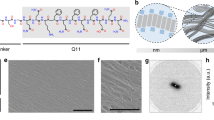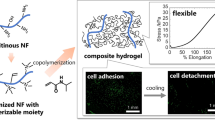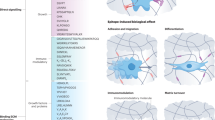Abstract
We recently developed a self-assembling peptide, E1Y9 (Ac-E-YEYKYEYKY-NH2), that forms supramolecular nanofibers with hydrogelation properties in response to Ca2+ ions. In this study, we proposed a new method to functionalize supramolecular peptide nanofibers using fiber-binding peptides screened from a phage peptide library. Three fiber-binding peptides, namely, p1, p2, and p3, were successfully identified. The RGDS-conjugated forms of these peptides, namely, p1-RGDS, p2-RGDS, and p3-RGDS, significantly enhanced the adhesion of 3T3-L1 cells on E1Y9 nanofibers through noncovalent modification of E1Y9 nanofibers. This noncovalent modification using fiber-binding peptides was also effective for functionalization of E1Y9 hydrogels, as E1Y9 hydrogels modified with p1-RGDS or p2-RGDS promoted the proliferation of 3T3-L1 cells, compared with the E1Y9 hydrogel alone. Since p1 and p2 could bind to different sites on E1Y9 nanofibers, the additional enhancement in cell proliferation on E1Y9 hydrogels was achieved using both p1-RGDS and p2-RGDS. Thus, the functionalization of supramolecular peptide nanofibers using molecular recognition peptides will be a powerful tool for the development of functional materials.
This is a preview of subscription content, access via your institution
Access options
Subscribe to this journal
Receive 12 print issues and online access
$259.00 per year
only $21.58 per issue
Buy this article
- Purchase on Springer Link
- Instant access to full article PDF
Prices may be subject to local taxes which are calculated during checkout






Similar content being viewed by others
References
Guan X, Adali MA, Alarçin E, Cheng H, Kashaf SS, Li Y. et al. Development of hydrogels for regenerative engineering. Biotechnol J. 2017;12:1600394.
Velmurugan BK, Priya LB, Poornima P, Lee L‐J, Baskaran R. Biomaterial aided differentiation and maturation ofinduced pluripotent stem cells. J Cell Physiol. 2019;234:8443–54.
Xu Y, Chen C, Hellwarth PB, Bao X. Biomaterials for stem cell engineering and biomanufacturing. Bioact Mater. 2019;New York4:366–79.
Du X, Zhou J, Shi J, Xu B. Supramolecular hydrogelators and hydrogels: from softmatter to molecular biomaterials. Chem Rev. 2015;115:13165–307.
Cortner RA, Hoffman WF. An interesting colloid gel. J Am Chem Soc. 1921;43:2199–202.
Tsutsumi H, Mihara H. Soft materials based on designed self-assembling peptides: from design to application. Mol BioSyst. 2013;9:609–17.
Li J, Xing R, Bai S, Yan X. Recent advances of self-assembling peptide-based hydrogelsfor biomedical applications. Soft Matter. 2019;15:1704–15.
Yokoi H, Kinoshita T, Zhang S. Dynamic reassembly of peptide RADA16 nanofiber scaffold. Proc Natl Acad Sci U S A. 2005;102:8414–9.
Sawada T, Tsuchiya M, Takahashi T, Tsutsumi H, Mihara H. Cell-adhesive hydrogels composed of peptide nanofibers responsive to biological ions. Polym J. 2012;44:651–7.
Fukunaga K, Tsutsumi H, Mihara H. Self-assembling peptide nanofibers promoting cell adhesion and differentiation. Biopolymers. 2013;100:731–7.
Fukunaga K, Tsutsumi H, Mihara H. Cell differentiation on disk-and string-shaped hydrogels fabricated from Ca2+-responsive self-assembling peptides. Biopolymers. 2015;106:476–83.
Tsutsumi H, Kawamura M, Mihara H. Osteoblastic differentiation on hydrogels fabricated from Ca2+-responsive self-assembling peptides functionalized with bioactive peptides. Bioorg Med Chem. 2018;26:3126–32.
Pugliese R, Gelain F. Peptidic biomaterials: from self-assemblingto regenerative medicine. Trend Biotechnol. 2017;35:145–58.
Liu R, Hudalla GA. Using self-assembling peptides to integrate biomolecules into functional supramolecular biomaterials. Molecules. 2019;24:1450.
Sawada T, Mihara H, Serizawa T. Peptides as new smart bionanomaterials: molecular-recognitionand self-assembly capabilities. Chem Rec. 2013;13:172–86.
Günay KA, Klok H-A. Identification of soft matter binding peptide ligands using phage display. Bioconjugate Chem. 2015;26:2002–15.
Serizawa T, Fukuta H, Date T, Sawada T. Affinity-based release of polymer-binding peptides from hydrogels with the target segments of peptides. Chem Commun. 2016;52:2241–4.
Sawada T, Takahashi T, Mihara H. Affinity-based screening of peptides recognizing assembly states of self-assembling peptide nanomaterials. J Am Chem Soc. 2009;131:14434–41.
Sawada T, Mihara H. Dense surface functionalization using peptides that recognize differences in organized structures of self-assembling nanomaterials. Mol BioSyst. 2012;8:1264–74.
Chan WC, White P D. Eds. Fmoc Solid Phase Peptide Synthesis. New York. Oxford University Press; 2000, 41–76.
New England Biolabs. Ph.D.-7TM Phage Display peptide library Kit Instruction manual ver. 2.7, 2003.
Acknowledgements
This work was supported in part by KAKENHI, MEXT, Japan. The authors thank the Biomaterials Analysis Division, Tokyo Institute of Technology, for DNA sequence analysis and TEM observations.
Author information
Authors and Affiliations
Corresponding authors
Ethics declarations
Conflict of interest
The authors declare that they have no conflict of interest.
Additional information
Publisher’s note Springer Nature remains neutral with regard to jurisdictional claims in published maps and institutional affiliations.
Rights and permissions
About this article
Cite this article
Tsutsumi, H., Matsubara, D. & Mihara, H. Functionalization of self-assembling peptide materials using molecular recognition of supramolecular peptide nanofibers. Polym J 52, 913–922 (2020). https://doi.org/10.1038/s41428-020-0337-6
Received:
Revised:
Accepted:
Published:
Issue Date:
DOI: https://doi.org/10.1038/s41428-020-0337-6



